Flexible Packaging Market Overview:
The global flexible packaging market size was valued at USD 197.4 billion in 2022, and is projected to reach USD 325.8 billion by 2032, growing at a CAGR of 5.1% from 2023 to 2032.
Key Market Insights
- By packaging type, the film segment held the highest market share for 2022
- By End Use Industry, the pharmaceutical segment is projected to manifest a CAGR of 7.4% from 2023 to 2032.
- By region, North America region is expected to witness the fastest CAGR of 6.03% during the forecast period.
Market Size & Forecast
- 2032 Projected Market Size: USD 325.8 Billion
- 2023 Market Size: USD 197.4 Billion
- Compound Annual Growth Rate (CAGR) (2023-2032): 5.1%
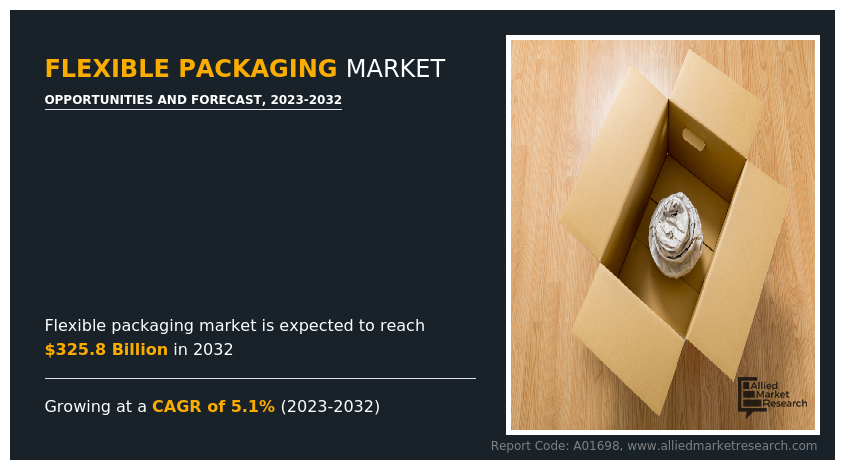
How to Describe Flexible Packaging
Flexible packaging is a type of packaging made from easily yielding materials such as plastic, film, foil, or paper, which can be shaped, folded, or sealed to protect and preserve products. It is widely used across industries such as food and beverage, pharmaceuticals, and consumer goods due to its lightweight nature, cost-effectiveness, and ability to extend product shelf life. Flexible packaging includes pouches, bags, wraps, and sachets, offering benefits such as reduced material usage, lower transportation costs, and enhanced convenience for consumers. Its versatility, combined with advancements in barrier properties and sustainability initiatives, makes it an increasingly preferred choice in modern packaging solutions.
Market Dynamics
Flexible packaging is one of the fastest-growing segments of the packaging industry, as it adds value, sustainability, and marketability to both food and non-food products by combining the best qualities of plastic, film, paper, and aluminum foil to deliver a broad range of protective properties while using the least amount of material. These versatile packaging supplies functional solutions that require minimal production costs. From consumer goods to electronics and cosmetics to medical supplies, flexible packaging is an important component in the supply chain of many industries and products.
Flexible packaging adds value and marketability to both food and non-food products by combining the finest qualities of plastic, film, paper, and aluminum foil to provide a wide range of protective properties with the least amount of material. An increase in demand for snack and convenience foods in small or single-size portions fuels the growth of the flexible packaging market. The packaging industry is moving toward flexible packaging, owing to its multi-fold energy and environmental advantages.
Flexible packaging combines the qualities of plastic, paper, and aluminum foil without compromising on the freshness, barrier protection, durability, printability, or simplicity of use of the product. Thus, multiple advantages associated with flexible packaging drive the growth of the global flexible packaging market. However, recycling of plastic packaging waste is a complex process that requires state-of-the-art infrastructural facilities. It is a time-consuming process that needs personnel expertise, which hampers the growth of the flexible packaging market.
Flexible Packaging Market Segment Review
The global flexible packaging market is segmented on the basis of material, packaging type, end-use industry, and region. On the basis of material, the market is categorized into paperboard, plastic, and aluminum foil. By packaging type, it is divided into stand-up pouch, films, bag-in-box, and others. Depending on end-use industry, it is segregated into food & beverages, personal care, pharmaceutical, household care, industrial, and others. Region wise, the flexible packaging market is studied across North America, Europe, Asia-Pacific, and LAMEA.
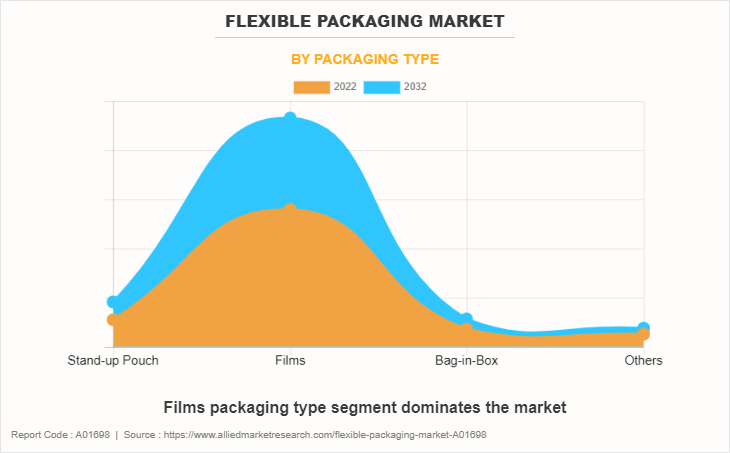
Flexible Packaging Market by Packaging Type
Based on packaging type, the film segment held the highest market share in 2022, accounting for more than two-third of the global flexible packaging market revenue, and is estimated to maintain its leadership status throughout the forecast period. Moreover, the film segment is projected to manifest a CAGR of 5.16% from 2023 to 2032. Packaging films are generally made of plastic, as it is light and relatively cheaper. These enable the preservation of the products for long durations. These are preferred by consumers in the food & beverages industry, owing to their aesthetic appeal that aids in its promotion. This will help propel the growth of the market during the forecast period. Furthermore, the market is expected to witness growth in the consumption of biodegradable films during the forecast period.
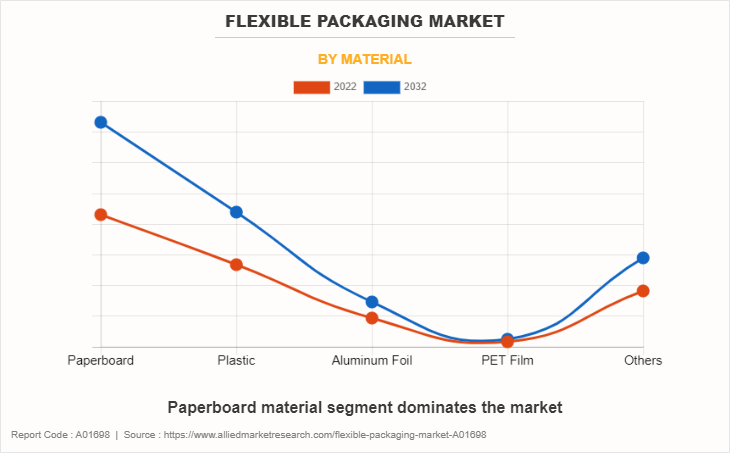
Flexible Packaging Market by Material
Based on material, paperboard segment held the highest market share in 2022, accounting for more than two-fifths of the global flexible packaging market revenue, and is estimated to maintain its leadership status throughout the forecast period. Moreover, paperboard segment is projected to manifest a CAGR of 5.38% from 2023 to 2032. The demand for paperboard-based flexible packaging materials is predominantly driven by the food & beverages industry, as they market their products such as milk, dairy products, juices, and soft drinks in cartons, tetra packs, and boxes.
Furthermore, recent advances in environmentally friendly packaging are helping packaging manufacturers meet the demand for recyclable products as consumers seek to reduce waste and limit the harmful impact of modern living on the environment. In addition, advancements in paperboard packaging is a major factor that fosters the flexible packaging market growth.
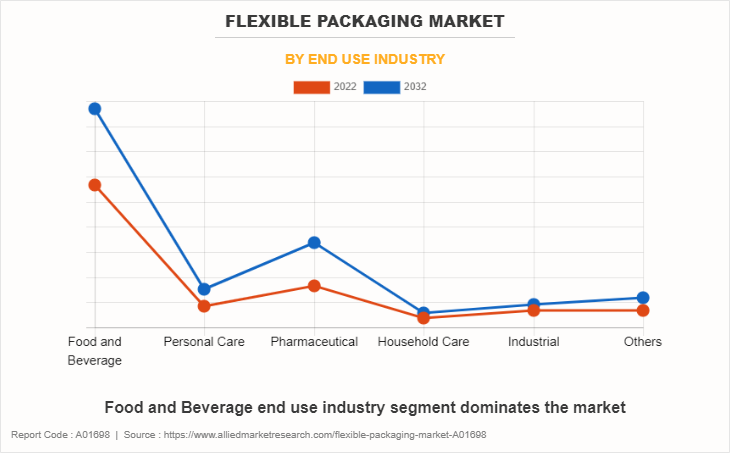
Flexible Packaging Market by End-Use Industry
Based on the End Use Industry, the food & beverage segment held the highest market share in 2022, accounting for nearly three-fifths of the global flexible packaging market revenue, and is estimated to maintain its leadership status throughout the forecast period. Moreover, the pharmaceutical segment is projected to manifest a CAGR of 7.4% from 2023 to 2032. Pharmaceutical packaging is witnessing high demand as healthcare demand rises and consumers become more conscious of the need to live a healthier lifestyle. Furthermore, enhanced drug delivery; expanding economy markets such as India, Thailand, and China; as well as new packaging solutions that improve patient comfort and compliance drive the pharmaceutical packaging industry.
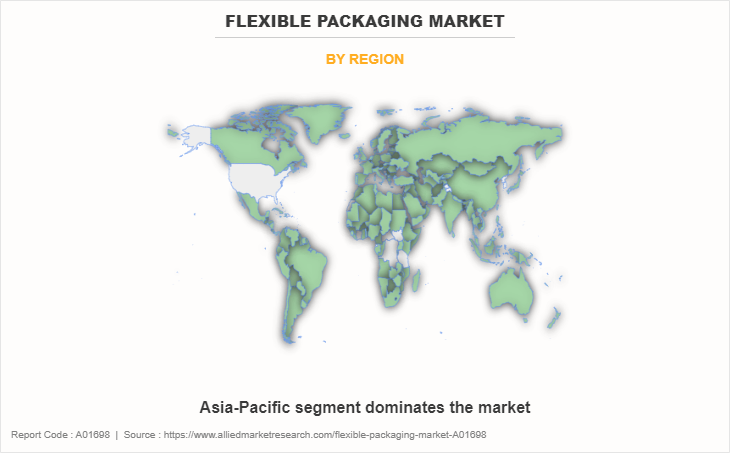
Flexible Packaging Market by Region
Based on region, Asia-Pacific held the highest market share in terms of revenue in 2022, accounting for nearly two-fifths of the global flexible packaging industry revenue, and is likely to dominate the market during the forecast period. However, the North America region is expected to witness the fastest CAGR of 6.03% from 2023 to 2032. The U.S. is the dominant country in the region in terms of flexible packaging market share, followed by Canada. Mexico shares the lowest share in the market. This is attributed to rise in activities in the on-site application of flexible packaging in the region.
The presence of big corporations and industrial giants drives the demand for flexible packaging. Moreover, the development of the personal care industry in Mexico acts as a key driving factor for the North America flexible packaging market. In addition, rise in demand for pharmaceuticals in Canada contributes to the market growth.
Which are the Leading Companies in Flexible Packaging
The major players operating in the global flexible packaging industry. These players have adopted product launches, joint ventures, partnerships, and expansion of the production capabilities to meet the future demand for the flexible packaging industry.
- Berry Global Inc.
- Amcor Plc
- FlexPak Services LLC
- Mondi Group
- Sealed Air Corporation
- Constantia Flexibles
- Transcontinental Inc.
- Coveris Holding SA
- Huhtamaki
- Sonoco
Which key developments have shaped the market recently
February 2024: Amcor entered into an agreement with Cadbury to supply 1,000 tons of post-consumer recycled plastic for packaging its core chocolate range. This initiative supports Cadbury’s commitment to reducing reliance on virgin plastic.
February 2024: Mondi expanded the production of its sustainable EcoWicketBags, a paper-based alternative for packaging in the HPC industry, particularly for diapers and feminine hygiene products. The company is ramping up production at its Szada (Hungary) plant, leveraging its integrated value chain, which encompasses in-house paper manufacturing, coating, and converting.
What are the Key Benefits For Stakeholders
This report provides a quantitative analysis of the market segments, current trends, estimations, and dynamics of the flexible packaging market analysis from 2022 to 2032 to identify the prevailing flexible packaging market opportunities.
The market research is offered along with information related to key drivers, restraints, and opportunities.
Porter's five forces analysis highlights the potency of buyers and suppliers to enable stakeholders make profit-oriented business decisions and strengthen their supplier-buyer network.
In-depth analysis of the flexible packaging market segmentation assists to determine the prevailing market opportunities.
Major countries in each region are mapped according to their revenue contribution to the global flexible packagingmarket.
Market player positioning facilitates benchmarking and provides a clear understanding of the present position of the market players.
The report includes the analysis of the regional as well as global flexible packaging market trends, key players, market segments, application areas, and market growth strategies.
Flexible Packaging Market Report Highlights
| Aspects | Details |
| Market Size By 2032 | USD 325.8 billion |
| Growth Rate | CAGR of 5.1% |
| Forecast period | 2022 - 2032 |
| Report Pages | 394 |
| By Material |
|
| By End Use Industry |
|
| By Packaging Type |
|
| By Region |
|
| Key Market Players | Mondi, CONSTANTIA FLEXIBLES, Huhtamaki, Sealed Air, COVERIS, Berry Global Inc., SONOCO PRODUCTS COMPANY, Amcor PLC, FLEXPAK SERVICES, Transcontinental Inc. |
Analyst Review
CXOs play a crucial role in the flexible packaging market, navigating a complex landscape that is influenced by evolving consumer preferences, technological advancements, and sustainability imperatives. They prioritize adaption to changing consumer demands and environmental considerations while focusing on eco-friendly materials and innovative, recyclable packaging solutions.
According to the opinions of various CXOs of leading companies, the flexible packaging market is driven by rapidly increasing demand for convenience food, growing urbanization, and rising awareness about environmental sustainability. Furthermore, Asia-Pacific is projected to register robust growth owing to the presence of the emerging economies such as China and India as they have huge potential with regards to the adoption of flexible packaging due to the changing lifestyle of consumers and the increasing population of working women. However, recycling of plastic packaging waste is a complex and time-consuming process that requires state-of-the-art infrastructural facilities, which is expected to hamper the growth of the flexible packaging market.
The CXOs further added that the recent trends in the flexible packaging market reflect a growing emphasis on sustainability, innovation, and convenience. Eco-friendly materials and recyclable packaging options have gained significant traction as consumers and industries increasingly prioritize environmental responsibility. Smart packaging solutions incorporating advanced technologies such as QR codes, radio frequency identification (RFID), and near-field communication (NFC) are witnessing high demand, enabling improved traceability and real-time information for both consumers and producers. In addition, the demand for flexible packaging with extended shelf life, barrier properties, and user-friendly features continues to rise. The market is witnessing a surge in the adoption of pouches, stand-up pouches, and flat-bottom bags due to their versatility and reduced environmental impact compared to traditional rigid packaging. With a focus on reducing waste and enhancing product visibility, the flexible packaging industry meets the evolving needs of consumers and addresses sustainability concerns in the global packaging industry landscape.
The estimated industry size of flexible packaging market in 2032 is about $325.8 billion.
Sustainable Packaging Solutions, Smart Packaging Technologies, Recyclable and Biodegradable Materials, Digital Printing in Flexible Packaging, Convenience and On-the-Go Packaging are the upcoming trends of Flexible Packaging Market in the world.
Food and beverages is the leading application of Flexible Packaging Market.
Asia-Pacific is the largest regional market for Flexible Packaging.
AMCOR PLC, BERRY GLOBAL INC, CONSTANTIA FLEXIBLES, COVERIS, FLEXPAK SERVICES are the top companies to hold the market share in Flexible Packaging.
Loading Table Of Content...
Loading Research Methodology...



